Chemical Profiling and Characterization of Different Cultivars of Cannabis sativa L. Inflorescences by SPME-GC-MS and UPLC-MS
Abstract
:1. Introduction
2. Materials and Methods
2.1. Materials
2.2. SPME Sampling
2.3. GC-MS Analysis
2.4. UPLC-MS Analysis
2.5. Statistical Analysis
3. Results
3.1. GC-MS Chemical Composition
3.2. UPLC-MS Chemical Composition
3.3. Multivariate Metabolomics Data Analysis
4. Discussion
5. Conclusions
Author Contributions
Funding
Institutional Review Board Statement
Informed Consent Statement
Data Availability Statement
Acknowledgments
Conflicts of Interest
References
- Small, E. Evolution and classification of Cannabis sativa (marijuana, hemp) in relation to human utilization. Bot. Rev. 2015, 81, 189–294. [Google Scholar] [CrossRef]
- CABI. Invasive Species Compendium. Cannabis Sativa (Hemp). Available online: https://www.cabi.org/isc/datasheet/14497 (accessed on 5 March 2022).
- Thomas, B.F.; ElSohly, M.A. The botany of Cannabis sativa L. In The Analytical Chemistry of Cannabis; Thomas, B.F., Ed.; Elsevier: Oxford, UK, 2016; pp. 1–26. [Google Scholar]
- Ren, G.; Zhang, X.; Li, Y.; Ridout, K.; Serrano-Serrano, M.L.; Yang, Y.; Liu, A.; Ravikanth, G.; Nawaz, M.A.; Mumtaz, A.S.; et al. Large-scale whole-genome resequencing unravels the domestication history of Cannabis sativa. Sci. Adv. 2021, 7, eabg2286. [Google Scholar] [CrossRef] [PubMed]
- Hurgobin, B.; Tamiru-Oli, M.; Welling, M.T.; Doblin, M.S.; Bacic, A.; Whelan, J.; Lewsey, M.G. Recent advances in Cannabis sativa genomics research. New Phytol. 2020, 230, 73–89. [Google Scholar] [CrossRef] [PubMed]
- Farinon, B.; Molinari, R.; Costantini, L.; Merendino, N. The seed of industrial hemp (Cannabis sativa L.): Nutritional quality and potential functionality for human health and nutrition. Nutrients 2020, 12, 1935. [Google Scholar] [CrossRef]
- Balant, M.; Gras, A.; Ruz, M.; Vallès, J.; Vitales, D.; Garnatje, T. Traditional uses of Cannabis: An analysis of the CANNUSE database. J. Ethnopharmacol. 2021, 279, 114362. [Google Scholar] [CrossRef] [PubMed]
- Pauli, C.S.; Conroy, M.; Vanden Heuvel, B.D.; Park, S.-H. Cannabidiol drugs clinical trial outcomes and adverse effects. Front. Pharmacol. 2020, 11, 63. [Google Scholar] [CrossRef] [PubMed]
- Johnson, R. Hemp as an Agricultural Commodity; CRS Report RL32725; Congressional Research Service: Washington, DC, USA, 2018; Available online: https://fas.org/sgp/crs/misc/RL32725.pdf (accessed on 11 March 2022).
- Lu, Y.; Young, S.; Linder, E.; Whipker, B.; Suchoff, D. Hyperspectral imaging with machine learning to differentiate cultivars, growth stages, flowers, and leaves of industrial hemp (Cannabis sativa L.). Front. Plant Sci. 2022, 12, 810113. [Google Scholar] [CrossRef] [PubMed]
- El Sohly, M.A.; Radwan, M.A.; Gul, W.; Chandra, S.; Galal, A. Phytochemistry of Cannabis sativa L. Prog. Chem. Org. Nat. Prod. 2017, 103, 1–36. [Google Scholar]
- Gonçalves, J.; Rosado, T.; Soares, S.; Simão, A.Y.; Caramelo, D.; Luís, A.; Fernández, N.; Barroso, M.; Gallardo, E.; Duarte, A.P. Cannabis and its secondary metabolites: Their use as therapeutic drugs, toxicological aspects, and analytical determination. Medicines 2019, 6, 31. [Google Scholar] [CrossRef] [Green Version]
- Jin, D.; Dai, K.; Xie, Z.; Chen, J. Secondary metabolites profiled in Cannabis inflorescences, leaves, stem barks, and roots for medicinal purposes. Sci. Rep. 2020, 10, 3309. [Google Scholar] [CrossRef] [PubMed]
- Lowe, H.; Steele, B.; Bryant, J.; Toyang, N.; Ngwa, W. Non-cannabinoid metabolites of Cannabis sativa L. with therapeutic potential. Plants 2021, 10, 400. [Google Scholar] [CrossRef] [PubMed]
- Radwan, M.M.; Chandra, S.; Gul, S.; ElSohly, M.A. Cannabinoids, phenolics, terpenes and alkaloids of Cannabis. Molecules 2021, 26, 2774. [Google Scholar] [CrossRef] [PubMed]
- Andre, C.M.; Hausman, J.-F.; Guerriero, G. Cannabis sativa: The plant of the thousand and one Molecules. Front. Plant Sci. 2016, 7, 19. [Google Scholar] [CrossRef] [PubMed] [Green Version]
- Solymosi, K.; Köfalvi, A. Cannabis: A treasure trove or pandora’s box? Mini-Rev. Med. Chem. 2017, 16, 1223–1291. [Google Scholar] [CrossRef] [PubMed]
- Kornpointner, C.; Martinez, A.S.; Marinovic, S.; Haselmair-Gosch, C.; Jamnik, P.; Schröder, K.; Löfke, C.; Halbwirth, H. Chemical composition and antioxidant potential of Cannabis sativa L. roots. Ind. Crops Prod. 2021, 165, 113422. [Google Scholar] [CrossRef]
- Appennino FARM. Available online: https://cannabislight.guru/ (accessed on 7 March 2022).
- Vitalini, S.; Iriti, M.; Vinciguerra, V.; Garzoli, S. A comparative study of the chemical composition by SPME-GC/MS and antiradical activity of less common citrus species. Molecules 2021, 26, 5378. [Google Scholar] [CrossRef]
- Iannone, M.; Ovidi, E.; Vitalini, S.; Laghezza Masci, V.; Marianelli, A.; Iriti, M.; Tiezzi, A.; Garzoli, S. From hops to craft beers: Production process, vocs profile characterization, total polyphenol and flavonoid content determination and antioxidant activity evaluation. Processes 2022, 10, 517. [Google Scholar] [CrossRef]
- Chong, J.; Wishart, D.S.; Xia, J. Using MetaboAnalyst 4.0 for comprehensive and integrative metabolomics data analysis. Curr. Protoc. Bioinform. 2019, 68, e86. [Google Scholar] [CrossRef] [PubMed]
- Downs, G.M.; Barnard, J.M. Clustering methods and their uses in computational chemistry. In Reviews in Computational Chemistry; Lipkowitz, K.B., Boyd, D.B., Eds.; Wiley: London, UK, 2002; pp. 1–40. [Google Scholar]
- Steinbach, M.; Ertoz, L.; Kumar, V. The challenges of clustering high dimensional data. In New Directions in Statistical Physics; Springer: Berlin/Heidelberg, Germany, 2004; pp. 273–309. [Google Scholar]
- Powell, W.; Morgante, M.; Andre, C.; Hanafey, M.; Vogel, J.; Tingey, S.; Rafalski, A. The comparison of RFLP, RAPD, AFLP and SSR (microsatellite) markers for 715 germplasm analysis. Mol. Breed. 1996, 2, 225–238. [Google Scholar] [CrossRef]
- Barker, M.; Rayens, W. Partial least squares for discrimination. J. Chemom. 2003, 17, 166–173. [Google Scholar] [CrossRef]
- Hood, L.V.S.; Barry, G.T. Headspace volatiles of marihuana and hashish: Gas chromatographic analysis of samples of different geographic origin. J. Chromatogr. 1978, 166, 499–506. [Google Scholar] [CrossRef]
- Rather, M.A.; Dar, B.A.; Sofi, S.N.; Hassan, T.; Ali, N.; Lone, A.H.; Shawl, A.S.; Shah, W.A.; Qurishi, M.A.; Prakash, P. Headspace solid phase microextraction (HS-SPME) gas chromatography mass spectrometric analysis of the volatile constituents of Cannabis sativa L. from Kashmir. J. Pharm. Res. 2011, 4, 2651–2653. [Google Scholar]
- Sheard, G.F. The chemical composition of the plant growing-point and its relation to the daily light exposure. Ann. Appl. Biol. 1940, 27, 305–310. [Google Scholar] [CrossRef]
- Namdar, D.; Mazuz, M.; Ion, A.; Kolta, H. Variation in the compositions of cannabinoid and terpenoids in Cannabis sativa derived from inflorescence position along the stem and extraction methods. Ind. Crops Prod. 2018, 113, 376–382. [Google Scholar] [CrossRef]
- Hilig, K.W. A chemotaxonomic analysis of terpenoid variation in Cannabis. Biochem. Syst. Ecol. 2004, 32, 875–891. [Google Scholar] [CrossRef]
- Farinon, B.; Costantini, L.; Molinari, R.; Di Matteo, G.; Garzoli, S.; Ferri, S.; Ceccantoni, B.; Mannina, L.; Merendino, N. Effect of malting on nutritional and antioxidant properties of the seeds of two industrial hemp (Cannabis sativa L.) cultivars. Food Chem. 2022, 370, 131348. [Google Scholar] [CrossRef]
- Palmier, S.; Fanti, F.; Oliva, E.; Viteritti, E.; Sergi, M.; Pepe, A.; Compagnone, D. Chemical characterization and evaluation of antioxidant activity from different cultivars of Cannabis sativa L. of Abruzzo’s region. Nat. Prod. Res. 2022, 15, 1–5. [Google Scholar] [CrossRef]
- Booth, J.K.; Bohlmann, J. Terpenes in Cannabis sativa—From plant genome to humans. Plant Sci. 2019, 284, 67–72. [Google Scholar] [CrossRef]
- Booth, J.K.; Page, J.E.; Bohlmann, J. Terpene synthases from Cannabis sativa L. PLoS ONE 2017, 12, e0173911. [Google Scholar] [CrossRef] [Green Version]
- Addo, P.W.; Brousseau, D.; Morello, V.; MacPherson, S.; Paris, M.; Lefsrud, M. Cannabis chemistry, post-harvest processing methods and secondary metabolite profiling: A review. Ind. Crop. Prod. 2021, 170, 113743. [Google Scholar] [CrossRef]
- Zhou, X.; Wang, F.; Zhou, R.; Song, X.; Xie, M. Apigenin: A current review on its beneficial biological activities. J. Food Biochem. 2017, 41, e12376. [Google Scholar] [CrossRef]
- Ryz, N.R.; Remillard, D.J.; Russo, E.B. Cannabis roots: A traditional therapy with future potential for treating inflammation and pain. Cannabis Cannabinoid Res. 2017, 2, 210–216. [Google Scholar] [CrossRef]
- Ben Amar, M. Cannabinoids in medicine: A review of their therapeutic potential. J. Ethnopharmacol. 2006, 105, 1–25. [Google Scholar] [CrossRef]
- Atakan, Z. Cannabis, a complex plant: Different compounds and different effects on individuals. Ther. Adv. Psychopharmacol. 2012, 2, 241–254. [Google Scholar] [CrossRef] [Green Version]
- Rea, K.A.; Casaretto, J.A.; Al-Abdul-Wahid, M.S.; Sukumaran, A.; McAlister, J.G.; Rothstein, S.J.; Akhtar, T.A. Biosynthesis of cannflavins A and B from Cannabis sativa L. Phytochemistry 2019, 164, 162–171. [Google Scholar] [CrossRef]
- Namdar, D.; Voet, H.; Ajjampura, V.; Nadarajan, S.; Mayzlish Gati, E.; Mazuz, M.; Shalev, N.; Koltai, H. Terpenoids and phytocannabinoids co-produced in Cannabis Sativa strains show specific interaction for cell cytotoxic activity. Molecules 2019, 24, 3031. [Google Scholar] [CrossRef] [Green Version]
- Marchini, M.; Charvoz, C.; Dujourdy, L.; Baldovini, N.; Filippi, J.J. Multidimensional analysis of cannabis volatile constituents: Identification of 5,5-dimethyl-1-vinylbicyclo[2.1.1]hexane as a volatile marker of hashish, the resin of Cannabis sativa L. J. Chromatogr. A 2014, 1370, 200–215. [Google Scholar] [CrossRef]
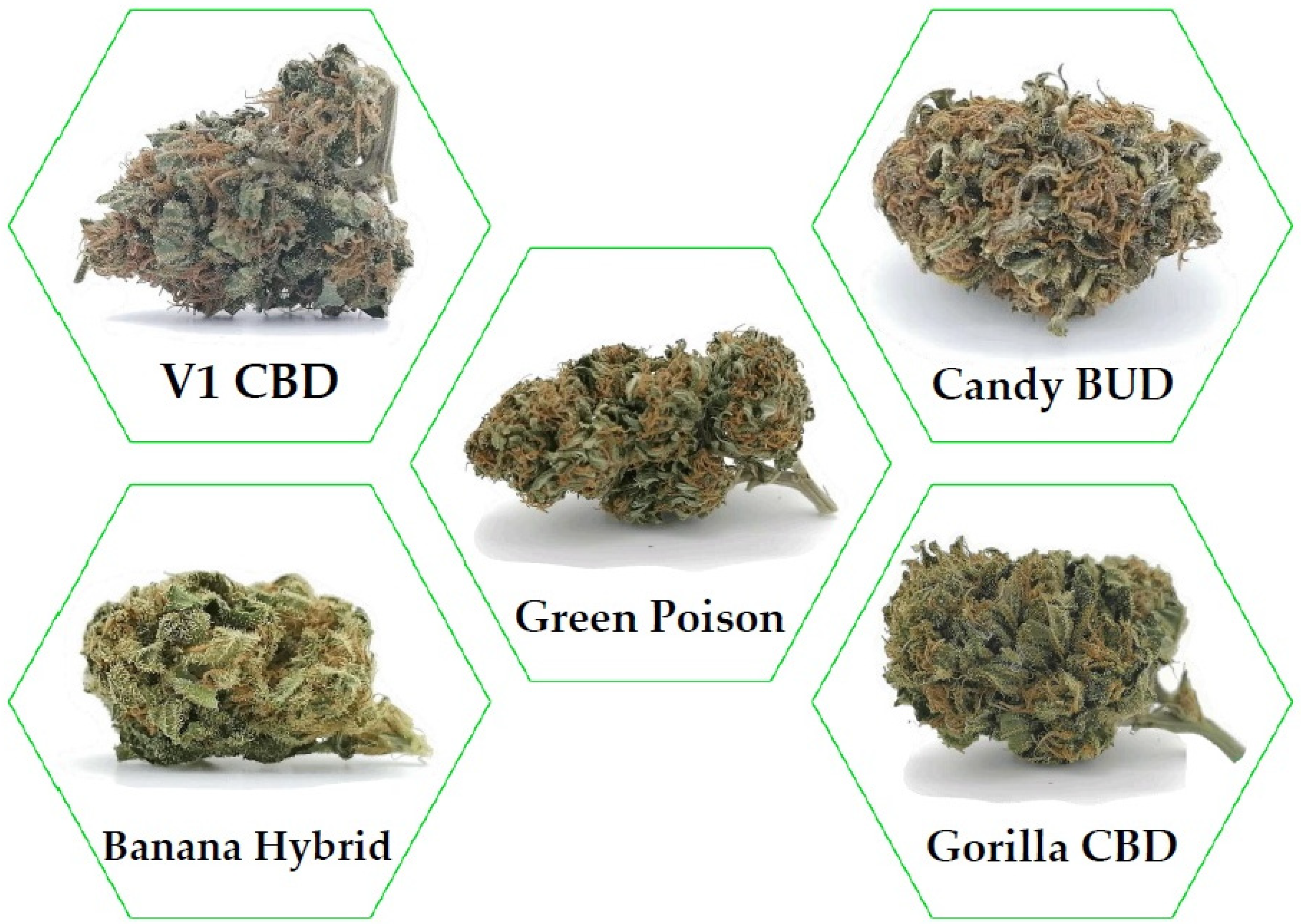
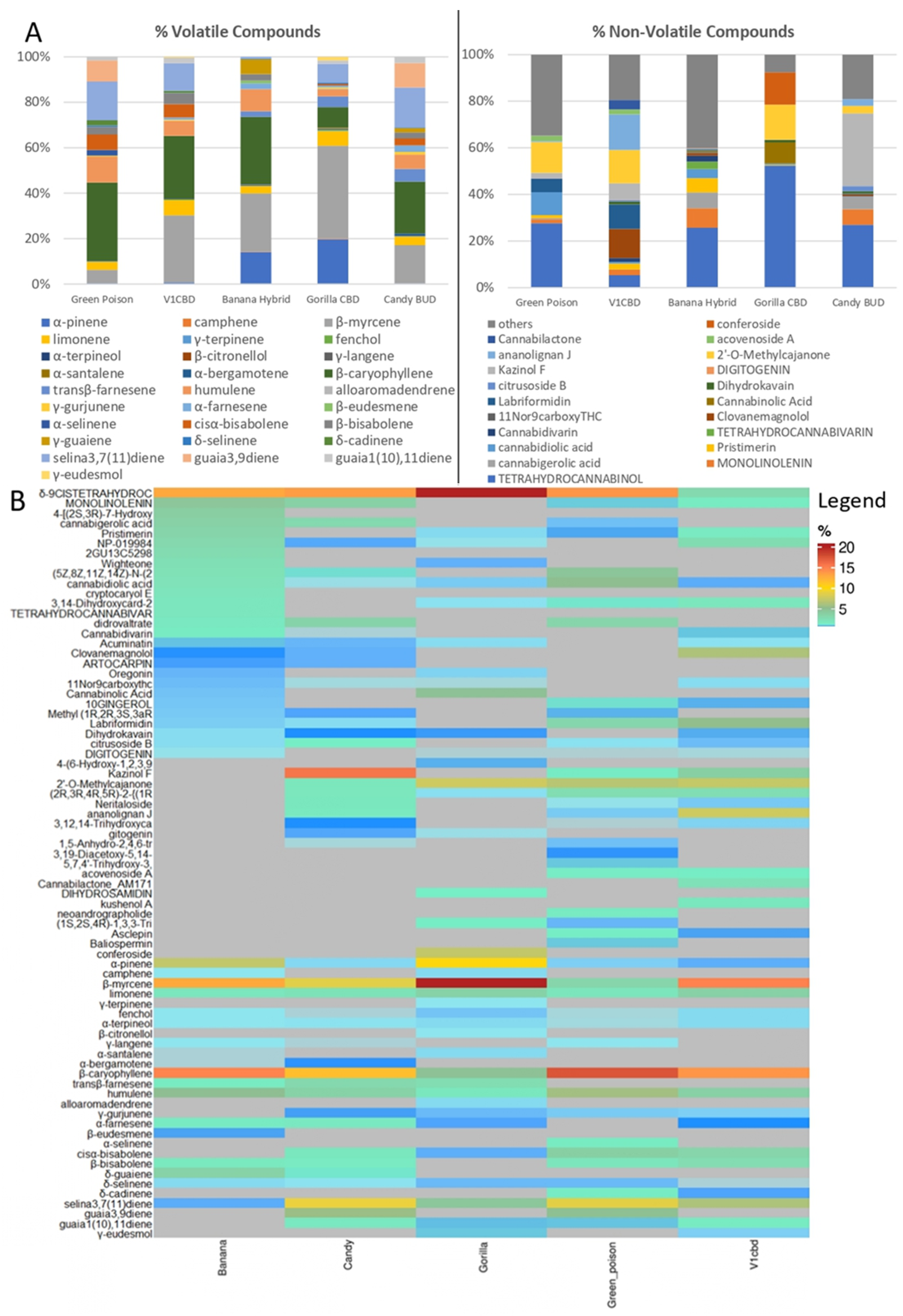
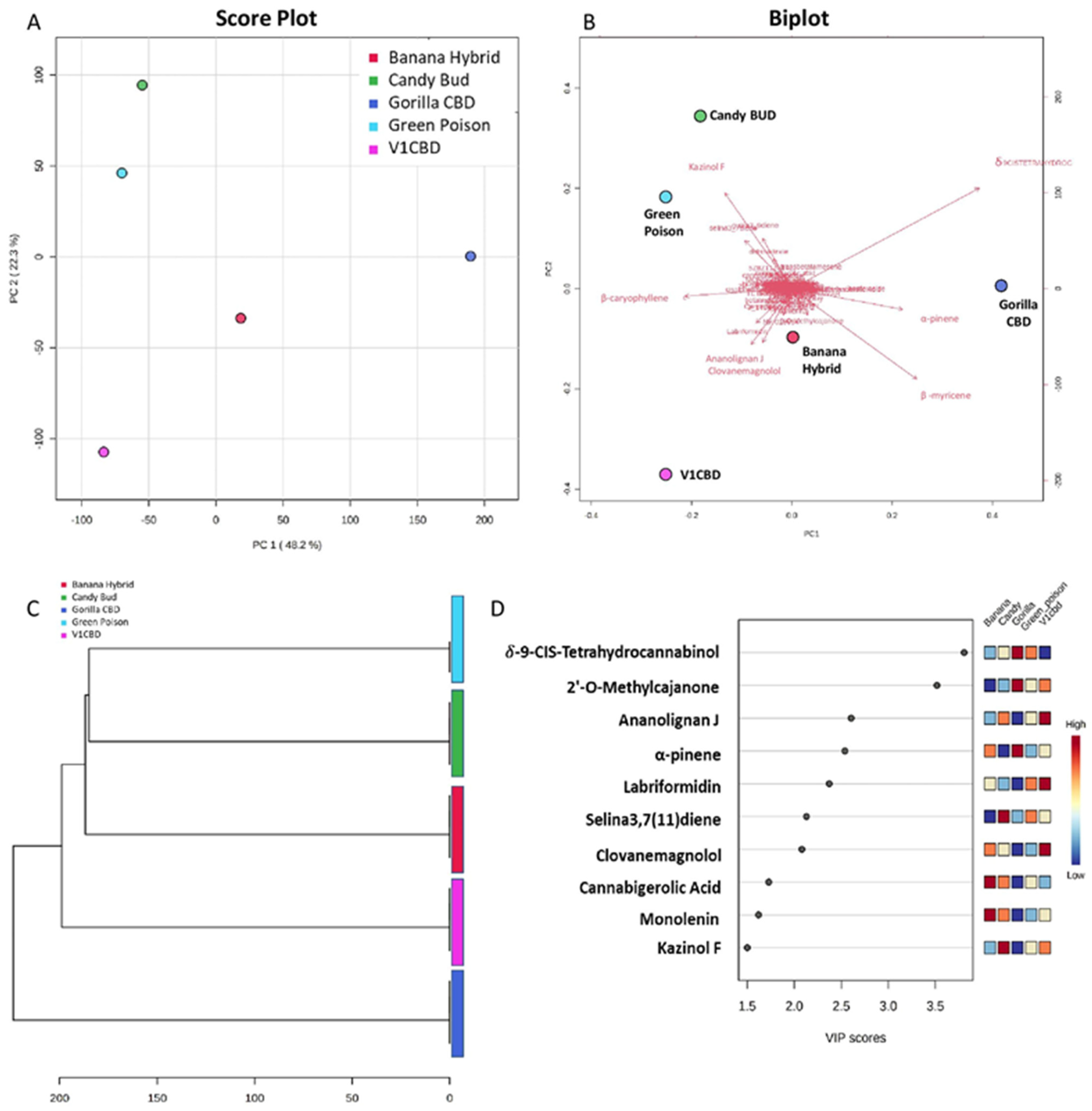
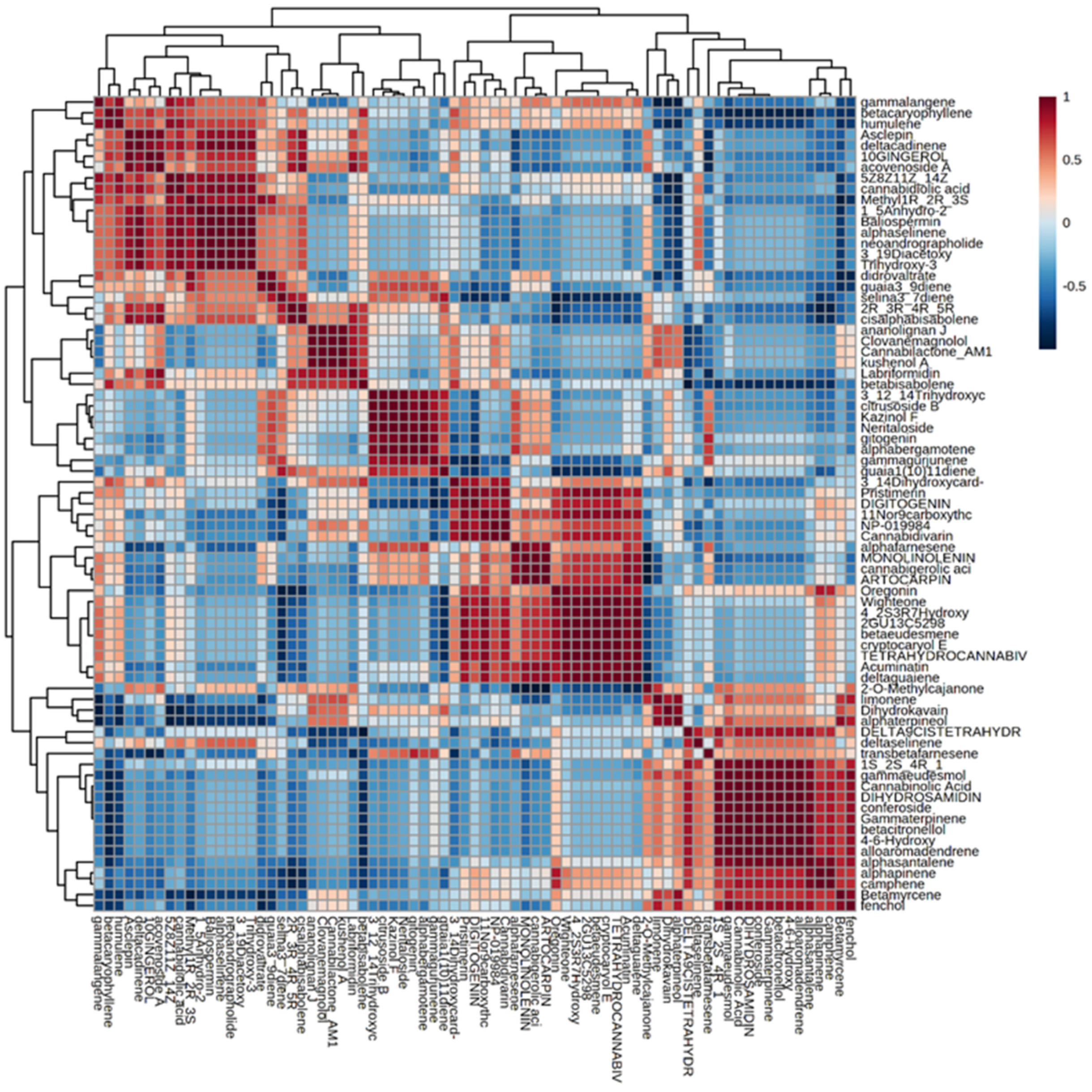
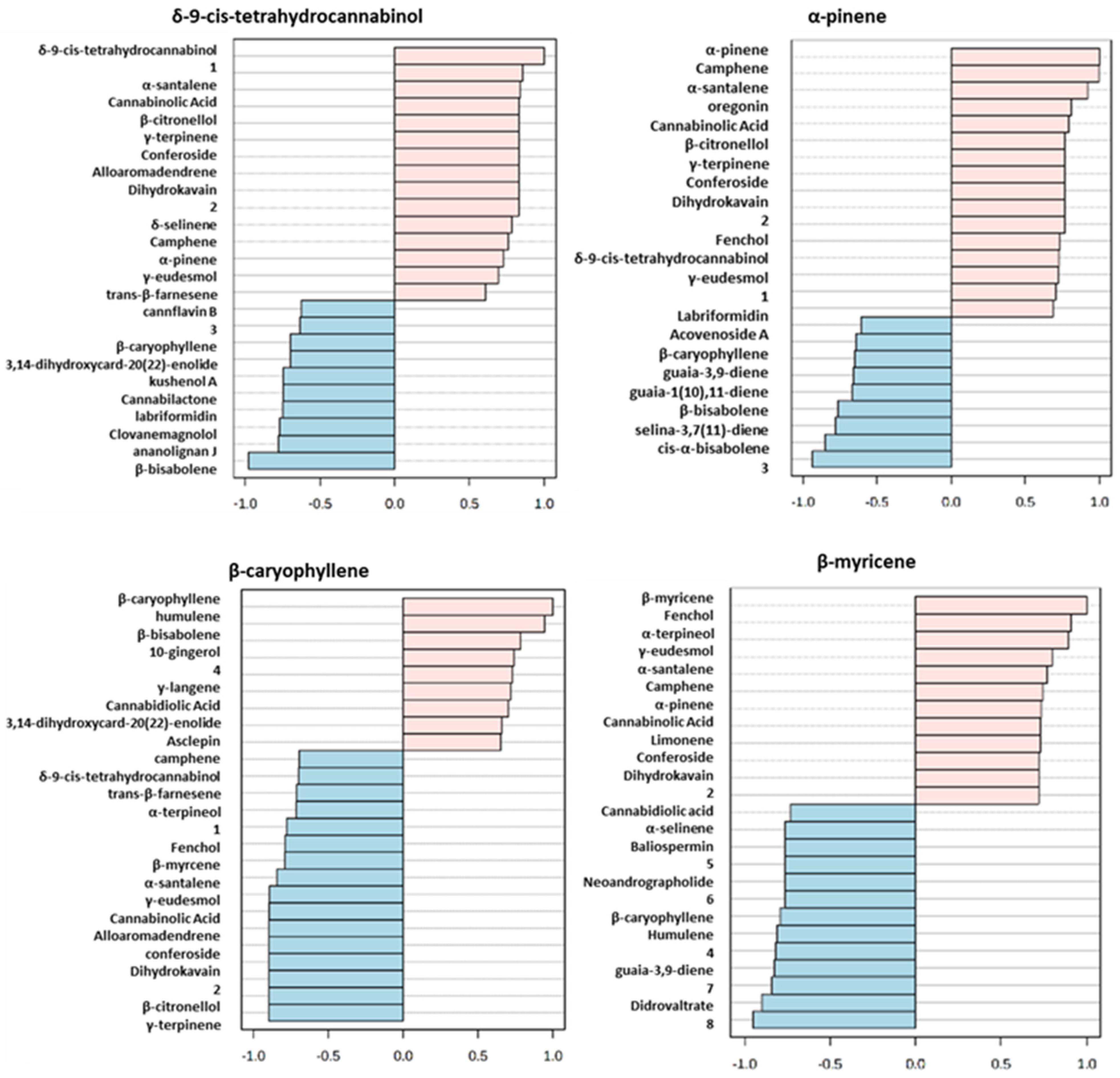
| No. | COMPONENT 1 | LRI 2 | LRI 3 | Green Poison | V1 CBD | Banana Hybrid | Gorilla CBD | Candy BUD |
|---|---|---|---|---|---|---|---|---|
| 1 | α-pinene | 941 | 943 | 0.4 ± 0.01 | 0.7 ± 0.02 | 13.7 ± 0.05 | 19.7 ± 0.04 | 0.3 ± 0.02 |
| 2 | camphene | 945 | 944 | - | - | 0.2 ± 0.02 | 0.3 ± 0.01 | - |
| 3 | β-myrcene | 990 | 987 | 5.9 ± 0.01 | 29.6 ± 0.02 | 25.0 ± 0.07 | 40.8 ± 0.11 | 15.9 ± 0.02 |
| 4 | limonene | 1031 | 1023 | 3.5 ± 0.01 | 6.7 ± 0.02 | 3.1 ± 0.04 | 6.4 ± 0.02 | 3.6 ± 0.02 |
| 5 | γ-terpinene | 1068 | 1065 | - | - | - | 0.2 ± 0.02 | - |
| 6 | fenchol | 1105 | 1100 | 0.1 ± 0.01 | 0.3 ± 0.01 | 0.2 ± 0.02 | 0.5 ± 0.02 | 0.1 ± 0.02 |
| 7 | α-terpineol | 1186 | 1183 | 0.1 ± 0.01 | 0.3 ± 0.02 | 0.2 ± 0.02 | 0.3 ± 0.02 | 0.2 ± 0.02 |
| 8 | β-citronellol | 1216 | 1212 | - | - | - | 0.2 ± 0.02 | - |
| 9 | y-langene | 1374 | 1376 | 0.2 ± 0.00 | - | 0.2 ± 0.02 | - | 0.1 ± 0.02 |
| 10 | α-santalene | 1418 | 1420 | - | - | 0.1 ± 0.02 | - | 0.9 ± 0.02 |
| 11 | α-bergamotene | 1433 | 1430 | - | - | 0.1 ± 0.01 | - | 0.9 ± 0.02 |
| 12 | β-caryophyllene | 1447 | 1440 | 34.5 ± 0.08 | 27.6 ± 0.04 | 28.9 ± 0.05 | 9.1 ± 0.03 | 21.6 ± 0.04 |
| 13 | trans-β-farnesene | 1449 | 1441 | - | - | 2.4 ± 0.03 | 4.7 ± 0.03 | 5.3 ± 0.03 |
| 14 | humulene | 1475 | 1473 | 11.4 ± 0.02 | 6.7 ± 0.03 | 9.5 ± 0.02 | 3.1 ± 0.02 | 6.0 ± 0.03 |
| 15 | γ-gurjunene | 1481 | 1479 | 0.4 ± 0.01 | 0.4 ± 0.02 | - | 0.6 ± 0.02 | 1.1 ± 0.02 |
| 16 | alloaromadendrene | 1484 | 1483 | - | - | - | 0.3 ± 0.02 | - |
| 17 | β-eudesmene | 1488 | 1486 | - | - | 1.2 ± 0.02 | - | - |
| 20 | α-selinene | 1490 | 1489 | 2.5 ± 0.01 | - | - | - | - |
| 21 | α-farnesene | 1493 | 1494 | - | 1.0 ± 0.01 | 2.4 ± 0.02 | 0.8 ± 0.03 | 2.7 ± 0.02 |
| 22 | cis-α-bisabolene | 1498 | 1496 | 6.8 ± 0.02 | 5.9 ± 0.02 | - | 0.7 ± 0.03 | 2.9 ± 0.02 |
| 23 | β-bisabolene | 1504 | 1501 | 3.4 ± 0.01 | 4.9 ± 0.08 | 2.8 ± 0.02 | - | 2.5 ± 0.01 |
| 24 | δ-guaiene | 1510 | 1508 | - | - | 6.4 ± 0.03 | - | 1.8 ± 0.02 |
| 25 | δ-selinene | 1512 | 1509 | 0.6 ± 0.01 | 0.1 ± 0.02 | 0.3 ± 0.02 | 0.6 ± 0.02 | 0.2 ± 0.02 |
| 26 | δ-cadinene | 1533 | 1530 | 2.3 ± 0.03 | 0.8 ± 0.01 | - | - | - |
| 28 | selina-3,7(11)-diene | 1537 | 1540 | 17.1 ± 0.06 | 12.2 ± 0.02 | 0.7 ± 0.02 | 8.2 ± 0.05 | 16.7 ± 0.02 |
| 29 | guaia-3,9-diene | 1560 | 1556 | 9.3 ± 0.01 | - | - | - | 10.2 ± 0.02 |
| 30 | γ-eudesmol | 1633 | 1630 | - | 0.4 ± 0.01 | - | 1.6 ± 0.02 | - |
| 31 | guaia-1(10),11-diene | 1760 | * | 1.5 ± 0.02 | 2.4 ± 0.02 | - | 1.5 ± 0.03 | 2.6 ± 0.02 |
| SUM | 100.0 | 100.0 | 97.4 | 99.6 | 95.6 | |||
| Terpenoids | 10.2 | 37.6 | 42.8 | 68.4 | 22.0 | |||
| Sesquiterpenoids | 89.8 | 62.4 | 54.6 | 31.2 | 73.6 |
| No. | COMPONENT 1 | Green Poison | V1 CBD | Banana Hybrid | Gorilla CBD | Candy BUD |
|---|---|---|---|---|---|---|
| 1 | δ-9-cis-tetrahydrocannabinol, (-)- (THC) | 27.4 ± 3.04 | 5.0 ± 0.67 | 25.4 ± 0.92 | 51.9 ± 3.10 | 26.7 ± 2.38 |
| 2 | monolinolenin | 1.6 ± 0.07 | 2.3 ± 0.03 | 8.3 ± 0.10 | - | 6.7 ± 0.59 |
| 3 | 4-[(2S,3R)-7-hydroxy-3-(hydroxymethyl)-5-(3-hydroxypropyl)-2,3-dihydro-1-benzofuran-2-yl]-2-methoxyphenyl 6-deoxy-α-L-mannopyranoside | - | - | 7.1 ± 0.09 | - | - |
| 4 | cannabigerolic acid (CBGA) | 0.5 ± 0.05 | - | 6.7 ± 0.08 | - | 5.3 ± 0.24 |
| 5 | pristimerin | 1.3 ± 0.06 | 2.4 ± 0.28 | 6.0 ± 0.08 | 0.3 ± 0.01 | - |
| 6 | cannflavin B | - | 4.5 ± 0.06 | 5.5 ± 0.07 | 0.2 ± 0.03 | 0.8 ± 0.03 |
| 7 | uscharidin | - | - | 5.0 ± 0.06 | - | - |
| 8 | wighteone | - | - | 4.4 ± 0.05 | 0.7 ± 0.04 | - |
| 9 | (5Z,8Z,11Z,14Z)-N-(2-furylmethyl)-5,8,11,14-icosatetraenamide | 8.5 ± 0.37 | - | 4.3 ± 0.05 | - | 1.8 ± 0.08 |
| 10 | cannabidiolic acid (CBDA) | 9.7 ± 0.43 | 0.7 ± 0.08 | 3.9 ± 0.05 | 0.4 ± 0.03 | 0.2 ± 0.03 |
| 11 | cryptocaryol E | tr | tr | 3.5 ± 0.04 | - | - |
| 12 | 3,14-dihydroxycard-20(22)-enolide | 1.9 ± 0.08 | 3.1 ± 0.04 | 3.2 ± 0.04 | 0.2 ± 0.02 | - |
| 13 | tetrahydrocannabivarin (THCV) | - | - | 3.1 ± 0.04 | - | - |
| 14 | didrovaltrate | 5.9 ± 0.26 | - | 2.7 ± 0.03 | - | 6.2 ± 0.00 |
| 15 | cannabidivarin (CBDV) | - | 1.5 ± 0.02 | 2.5 ± 0.03 | - | 0.1 ± 0.00 |
| 16 | acuminatin | - | 0.2 ± 0.03 | 1.5 ± 0.02 | 0.3 ± 0.02 | 0.6 ± 0.03 |
| 17 | clovanemagnolol | - | 11.5 ± 0.14 | 1.0 ± 0.01 | - | 0.7 ± 0.03 |
| 18 | artocarpin | - | - | 0.8 ± 0.01 | - | 0.7 ± 0.03 |
| 19 | oregonin | - | - | 0.6 ± 0.01 | 0.3 ± 0.02 | - |
| 20 | 11-nor-9-carboxy-tetrahydrocannabinol | - | 0.3 ± 0.00 | 0.6 ± 0.01 | 0.1 ± 0.01 | 0.1 ± 0.00 |
| 21 | cannabinolic acid (CBNA) | - | - | 0.5 ± 0.01 | 9.0 ± 0.60 | - |
| 22 | 10-gingerol | 1.8 ± 0.08 | 1.3 ± 0.02 | 0.5 ± 0.01 | - | - |
| 23 | methyl (1R,2R,3S,3ar,8bs)-2,3,3a,8b-tetrahydro-1,6,8b-trihydroxy-8-methoxy-3a-(4-methoxyphenyl)-3-phenyl-1H-cyclopenta[b]benzofuran-2-carboxylate | 1.4 ± 0.06 | - | 0.4 ± 0.01 | - | 0.8 ± 0.04 |
| 24 | labriformidin | 5.7 ± 0.25 | 9.6 ± 0.12 | 0.4 ± 0.00 | - | 0.3 ± 0.01 |
| 25 | dihydrokavain | tr | 1.2 ± 0.02 | 0.3 ± 0.00 | 1.1 ± 0.07 | 1.0 ± 0.05 |
| 26 | citrusoside B | 0.2 ± 0.02 | 0.5 ± 0.01 | 0.3 ± 0.00 | - | 2.2 ± 0.10 |
| 27 | digitogenin | 0.1 ± 0.00 | 0.1 ± 0.00 | 0.2 ± 0.00 | 0.1 ± 0.00 | - |
| 28 | 4-(6-hydroxy-1,2,3,9a-tetrahydro-3ah-spiro[cyclopenta[b]chromene-9,1′-cyclopentan]-3a-yl)-1,3-benzenediol | tr | - | - | 1.3 ± 0.09 | - |
| 29 | 1,2-benzenediol, 5-(3-(2,4-dihydroxyphenyl)propyl)-3,4-bis(3-methyl-2-butenyl)- | 2.3 ± 0.10 | 6.5 ± 0.08 | - | - | 31.0 ± 1.4 |
| 30 | 5-hydroxy-7-[4-hydroxy-2-methoxy-5-(3-methyl-2-butenyl)phenyl]-2,2-dimethyl-7,8-dihydro-2H,6H-pyrano[3,2-g]chromen-6-one | 13.1 ± 0.57 | 13.4 ± 0.17 | - | 14.8 ± 0.99 | 3.2 ± 0.016 |
| 31 | (2R,3R,4R,5R)-2-{(1R)-5-[(5R,7R)-1,6-dioxaspiro[4.5]dec-7-yl]-1-hydroxypentyl}-5-(hydroxymethyl)-3,4-pyrrolidinediol | 4.7 ± 0.21 | 4.2 ± 0.05 | - | 0.3 ± 0.01 | 3.2 ± 0.15 |
| 32 | neritaloside | 0.2 ± 0.01 | 0.4 ± 0.01 | - | - | 3.0 ± 0.14 |
| 33 | ananolignan J | 0.4 ± 0.02 | 14.1 ± 0.17 | - | - | 2.8 ± 0.13 |
| 34 | 3,12,14-trihydroxycard-20(22)-enolide | 0.1 ± 0.00 | 0.3 ± 0.00 | - | - | 1.0 ± 0.05 |
| 35 | gitogenin | - | - | - | 0.2 ± 0.01 | 0.8 ± 0.03 |
| 36 | 1,5-anhydro-2,4,6-tris-O-(3,4,5-trihydroxybenzoyl)-D-glucitol | 0.5 ± 0.02 | - | - | - | 0.1 ± 0.01 |
| 37 | 3,19-diacetoxy-5,14-dihydroxycard-20(22)-enolide | 1.1 ± 0.05 | - | - | - | - |
| 38 | 5,7,4′-trihydroxy-3,6-dimethoxy-3′,5′-diprenylflavone | 1.6 ± 0.077 | - | - | - | - |
| 39 | acovenoside A | 2.3 ± 0.10 | 2.0 ± 0.02 | - | - | - |
| 40 | cannabilactone | - | 3.8 ± 0.05 | - | - | - |
| 41 | cihydrosamidin | - | - | 2.0 ± 0.13 | - | |
| 42 | kushenol A | - | 2.9 ± 0.04 | - | - | - |
| 43 | neoandrographolide | 2.4 ± 0.11 | - | - | - | - |
| 44 | (1S,2S,4R)-1,3,3-trimethylbicyclo[2.2.1]hept-2-yl (6ar,10ar)-1-hydroxy-6,6,9-trimethyl-3-pentyl-6a,7,8,10a-tetrahydro-6H-benzo[c]chromene-2-carboxylate | 0.6 ± 0.03 | - | - | 2.1 ± 0.14 | - |
| 45 | asclepin | 2.2 ± 0.10 | 1.1 ± 0.01 | - | - | - |
| 46 | baliospermin | 1.6 ± 0.07 | - | - | - | - |
| 47 | conferoside | - | - | 13.8 ± 0.92 | - | |
| SUM | 99.1 | 92.9 | 98.7 | 99.1 | 99.1 |
Publisher’s Note: MDPI stays neutral with regard to jurisdictional claims in published maps and institutional affiliations. |
© 2022 by the authors. Licensee MDPI, Basel, Switzerland. This article is an open access article distributed under the terms and conditions of the Creative Commons Attribution (CC BY) license (https://creativecommons.org/licenses/by/4.0/).
Share and Cite
Cicaloni, V.; Salvini, L.; Vitalini, S.; Garzoli, S. Chemical Profiling and Characterization of Different Cultivars of Cannabis sativa L. Inflorescences by SPME-GC-MS and UPLC-MS. Separations 2022, 9, 90. https://doi.org/10.3390/separations9040090
Cicaloni V, Salvini L, Vitalini S, Garzoli S. Chemical Profiling and Characterization of Different Cultivars of Cannabis sativa L. Inflorescences by SPME-GC-MS and UPLC-MS. Separations. 2022; 9(4):90. https://doi.org/10.3390/separations9040090
Chicago/Turabian StyleCicaloni, Vittoria, Laura Salvini, Sara Vitalini, and Stefania Garzoli. 2022. "Chemical Profiling and Characterization of Different Cultivars of Cannabis sativa L. Inflorescences by SPME-GC-MS and UPLC-MS" Separations 9, no. 4: 90. https://doi.org/10.3390/separations9040090
APA StyleCicaloni, V., Salvini, L., Vitalini, S., & Garzoli, S. (2022). Chemical Profiling and Characterization of Different Cultivars of Cannabis sativa L. Inflorescences by SPME-GC-MS and UPLC-MS. Separations, 9(4), 90. https://doi.org/10.3390/separations9040090








